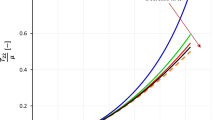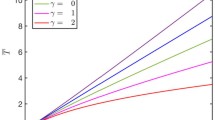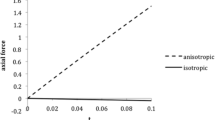Abstract
Stretch-based constitutive models for isotropic hyperelastic materials as alternatives to the classical strain invariant models have been the subject of considerable recent attention largely motivated by application to modelling the mechanical response of soft tissues. One such four-parameter constitutive model was proposed recently by Anssari-Benam (J. Elast. 153:219–244, 2023) for incompressible isotropic hyperelastic soft materials. The model was deemed to be comprehensive in that several well-known strain-energies may be recovered for some particular and limiting values of some of the parameters. The model is a generalization of several related simpler models based on microstructural considerations that have been shown to match well with experimental data for a wide variety of soft materials. In particular, the celebrated one-term Ogden model is obtained as a special case. Here we examine the response of the new model for the problem of pure torsion for a solid circular cylinder with particular emphasis on the Poynting effects governing the lengthening or shortening of the cylinder.
Similar content being viewed by others
References
Anssari-Benam, A.: Large isotropic elastic deformations: on a comprehensive model to correlate the theory and experiments for incompressible rubber-like materials. J. Elast. 153, 219–244 (2023)
Ogden, R.W.: Large deformation isotropic elasticity-on the correlation of theory and experiment for incompressible rubberlike solids. Proc. R. Soc. Lond. A 326, 565–584 (1972)
Horgan, C.O., Murphy, J.G.: Exponents of the one-term Ogden model: insights from simple shear. Philos. Trans. R. Soc. Lond. A 380, 20210328 (2022)
Lohr, M.J., Sugerman, G.P., Kakaletsis, S., Lejeune, E., Rausch, M.K.: An introduction to the Ogden model in biomechanics: benefits, implementation tools and limitations. Philos. Trans. R. Soc. Lond. A 380, 20210365 (2022)
Horgan, C.O.: On homogeneous deformations for a new constitutive model for incompressible isotropic hyperelastic soft materials. Mech. Soft Mater. 5, Article ID 3 (2023)
Horgan, C.O., Murphy, J.G.: Limiting chain extensibility models of Valanis-Landel type. J. Elast. 86, 101–111 (2007)
Gent, A.N.: A new constitutive relation for rubber. Rubber Chem. Technol. 69, 59–61 (1996)
Anssari-Benam, A., Destrade, M., Saccomandi, G.: Modelling brain tissue with the Ogden model and an alternative family of constitutive models. Phil. Trans. Roy. Soc. Lond. A 380, 20210325 (2022)
Anssari-Benam, A.: On a new class of non-Gaussian molecular based constitutive models with limiting chain extensibility for incompressible rubber-like materials. Math. Mech. Solids 26, 1660–1674 (2021)
Anssari-Benam, A., Bucchi, A.: A generalised neo-Hookean strain energy function for application to the finite deformation of elastomers. Int. J. Non-Linear Mech. 128, 103626 (2021)
Anssari-Benam, A., Horgan, C.O.: On modelling simple shear for isotropic incompressible rubber-like materials. J. Elast. 147, 83–111 (2021)
Anssari-Benam, A., Horgan, C.O.: Extension and torsion of rubber-like hollow and solid circular cylinders for incompressible isotropic hyperelastic materials with limiting chain extensibility. Eur. J. Mech. A, Solids 92, 104443 (2022)
Anssari-Benam, A., Horgan, C.O.: New results in the theory of plane strain flexure of incompressible isotropic hyperelastic materials. Proc. R. Soc. Lond. A 478, 20210773 (2022)
Anssari-Benam, A., Horgan, C.O.: New constitutive models for the finite deformation of isotropic compressible elastomers. Mech. Mater. 172, 104403 (2022)
Anssari-Benam, A.: Comparative modelling results between a separable and a non-separable form of principal stretches-based strain energy functions for a variety of isotropic incompressible soft solids: Ogden model compared with a parent model. Mech. Soft Mater. 5, Article ID 2 (2023)
Horgan, C.O.: A note on a class of generalized neo-Hookean models for isotropic incompressible hyperelastic materials. Int. J. Non-Linear Mech. 129, 103665 (2021)
Horgan, C.O., Murphy, J.G.: Pure torsion for incompressible hyperelastic materials of Valanis-Landel form. Proc. R. Soc. Lond. A 479, 20230011 (2023)
Horgan, C.O., Murphy, J.G.: Simple shearing of incompressible and slightly compressible isotropic nonlinearly elastic materials. J. Elast. 98, 205–221 (2010)
Horgan, C.O., Murphy, J.G.: Poynting and reverse Poynting effects in soft materials. Soft Matter 13, 4916–4923 (2017)
Mihai, L.A., Goriely, A.: Positive or negative Poynting effect? The role of adscititious inequalities in hyperelastic materials. Proc. R. Soc. Lond. A 467, 3633–3646 (2011)
Vitral, E.: Stretch formulations and the Poynting effect in nonlinear elasticity. Int. J. Non-Linear Mech. 148, 104293 (2023)
Horgan, C.O., Vitral, E.: Further results on stretch formulations of simple shear and pure torsion for incompressible isotropic hyperelastic materials. J. Elast. 153, 207–217 (2023)
Balbi, V., Trotta, M., Destrade, M., NiAnnaidh, A.: Poynting effect of brain matter in torsion. Soft Matter 15, 5147–5153 (2019)
Misra, A., et al.: Pantographic metamaterials show atypical Poynting effect reversal. Mech. Res. Commun. 89, 6–10 (2018)
Ghobani, A., et al.: Inverted and programmable Poynting effects in metamaterials. Adv. Sci. 8(20), Article ID e2102279 (2021)
Horgan, C.O., Saccomandi, G.: A description of arterial wall mechanics using limiting chain extensibility constitutive models. Biomech. Model. Mechanobiol. 1, 251–266 (2003)
Horgan, C.O., Saccomandi, G.: Simple torsion of isotropic, hyperelastic, incompressible materials with limiting chain extensibility. J. Elast. 56, 159–170 (1999)
Kanner, L.M., Horgan, C.O.: On extension and torsion of strain-stiffening rubber-like elastic circular cylinders. J. Elast. 93, 39–61 (2008)
Ogden, R.W.: Non-linear Elastic Deformations. Ellis Horwood, Chichester (1984). Reprinted by Dover, New York, 1997
Horgan, C.O., Murphy, J.G.: A perturbation analysis of pure torsion of incompressible hyperelastic cylinders. Int. J. Non-Linear Mech. 158, #104576 (2024)
Acknowledgements
The author is grateful to A. Anssari-Benam and J. G. Murphy for helpful comments on an earlier version of the manuscript.
Author information
Authors and Affiliations
Contributions
This work is the sole contribution of the corresponding author
Corresponding author
Ethics declarations
Competing interests
The author declares no competing interests.
Additional information
Publisher’s Note
Springer Nature remains neutral with regard to jurisdictional claims in published maps and institutional affiliations.
Appendices
Appendix A: Evaluation of the Integrals (3.26), (3.27)
We recall from Sect. 3 that
and
where \(H\) is given by
and where \(g(x)\) and \(h(x)\) are given by
Case 1 \(n = 3, \alpha = 2 \): Verification of (4.9), (4.10)
Thus we have
To evaluate \(K_{1}\), it proves convenient to combine the first and third integrals in (A.1) to get
The second integral in (A.1), denoted by \(I_{2}\), can be converted to an integral with the same upper limit as in (A.6) on using an obvious change of variable to read
Thus we find that
It is convenient to rewrite this as
so that we obtain
On evaluation and using the fact that \(\lambda _{A}^{2} + \lambda _{A}^{ - 2} = 2 + \psi ^{2}A^{2}\), we find that
On substitution into (4.6) and using the first of (4.8), we recover (4.9) as desired. The derivation of (4.10) follows along similar lines.
Case 2 \(n \to \infty , \alpha = 2 \):Verification of (4.15).
When \(\alpha = 2\), we have, on recalling (3.15), (3.18) and (4.12),
Proceeding from (4.13) as in (A.6)–(A.11), and setting \(J_{m} = 3\left ( N - 1 \right )\) one finds that
which is the result (4.15). This is exactly the result obtained in [27] for the Gent model derived on using the classical invariant approach.
Appendix B: Evaluation of the Integrals \(K_{3}\), \(K_{4}\)
\(\alpha = 6\): We recall from (3.26) in Sect. 3 that in this case
where \(H\) is given by
and where \(g(x)\) is given by
To evaluate \(K_{3}\), it proves convenient to combine the first and third integrals in (B.1) to get
The second integral in (B.1) can be combined with (B.4) on using a change of variable and so one obtains the analog of (A.8) namely
This can be rewritten as
The first two integrals are readily evaluated to give
where \(J_{1}\) is given by
\(\alpha = 8\):
In this case, the analog of (B.5) is
This can be rewritten as
Thus we obtain
where \(J_{2}\) is given by
Rights and permissions
Springer Nature or its licensor (e.g. a society or other partner) holds exclusive rights to this article under a publishing agreement with the author(s) or other rightsholder(s); author self-archiving of the accepted manuscript version of this article is solely governed by the terms of such publishing agreement and applicable law.
About this article
Cite this article
Horgan, C.O. Pure Torsion for Stretch-Based Constitutive Models for Incompressible Isotropic Hyperelastic Soft Materials. J Elast (2024). https://doi.org/10.1007/s10659-024-10048-x
Received:
Accepted:
Published:
DOI: https://doi.org/10.1007/s10659-024-10048-x
Keywords
- Incompressible isotropic hyperelastic soft materials
- Stretch-based formulation
- New constitutive model
- One-term Ogden model
- Pure torsion
- Classical and reverse Poynting effects




